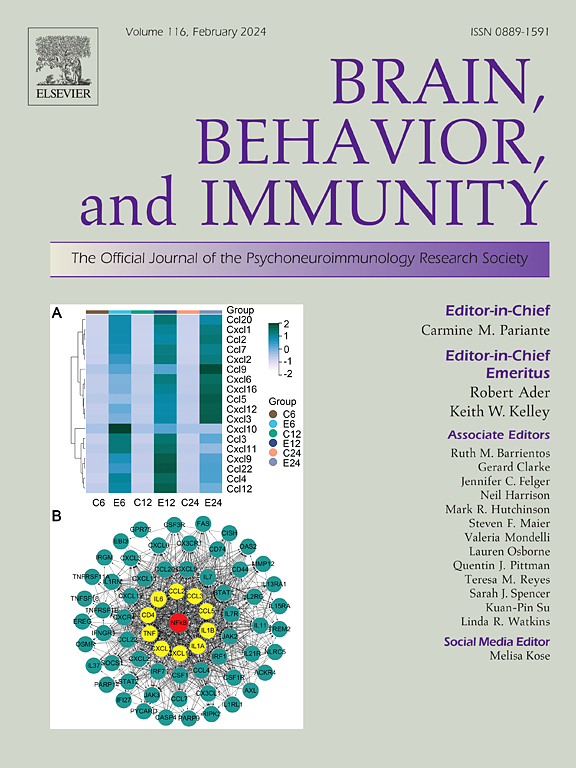Association of immune-inflammatory biomarkers during pregnancy and the postpartum period with postpartum depression symptoms: A cross-sectional and longitudinal retrospective analysis
IF 8.8
2区 医学
Q1 IMMUNOLOGY
引用次数: 0
Abstract
Background
Postpartum depression (PPD) is characterized by feelings of sadness, hopelessness, and disinterest in daily activities, leading to detrimental effects on both maternal and child well-being. We aimed to investigate the associations between blood immune-inflammatory biomarkers during pregnancy and the postpartum period and the risk of PPD.
Methods
In this study, we included postpartum women who underwent routine blood tests during second and third trimester visits as well as postpartum reviews. Immune-inflammatory biomarkers were assessed at three time points: neutrophil-to-lymphocyte ratio (NLR), lymphocyte-to-monocyte ratio (LMR), platelet-to-lymphocyte ratio (PLR), systemic immune-inflammatory index (SII), systemic inflammatory response index (SIRI), and pan-immune-inflammatory value (PIV). PPD symptoms were assessed at five to eight weeks postpartum using the Edinburgh Postnatal Depression Scale (EPDS). Multivariable logistic regression, restricted cubic spline (RCS) regression, and subgroup and sensitivity analyses were used to examine the relationships between immune-inflammatory biomarkers and PPD symptoms.
Results
Of the 17,500 women eligible for analysis, 2,576 (14.72 %) exhibited PPD symptoms. During the postpartum period, maternal lymphocyte count was associated with decreased odds of PPD symptoms (OR = 0.86, 95 % CI: [0.80, 0.93]), whereas NLR, PLR, and SII were associated with increased odds of PPD symptoms after Bonferroni correction (OR = 1.19, 95 % CI: [1.06, 1.34]; OR = 1.40, 95 % CI: [1.21, 1.61]; OR = 1.18, 95 % CI: [1.07, 1.30], respectively). The relationships showed significant linear trends (all P for nonlinear > 0.05). Subgroup analyses demonstrated that cesarean delivery could modify the association between NLR and PPD symptoms (P for interaction = 0.034). The significant association between NLR and PPD symptoms was observed only in women without cesarean delivery (OR = 1.31, 95 % CI: [1.13, 1.52]). Sensitivity analyses showed that the main findings remained robust.
Conclusions
Our findings suggest that lymphocyte count, NLR, PLR, and SII during the postpartum period are independent risk factors for PPD symptoms. Monitoring these biomarkers could aid in clinical decision-making and the implementation of effective PPD management strategies.
妊娠和产后期间免疫炎症生物标志物与产后抑郁症状的关联:横断面和纵向回顾性分析
产后抑郁症(PPD)的特点是感到悲伤、绝望和对日常活动不感兴趣,对母亲和儿童的健康都有不利影响。我们的目的是研究妊娠和产后期间血液免疫炎症生物标志物与PPD风险之间的关系。方法在本研究中,我们纳入了在妊娠中期和晚期进行常规血液检查以及产后复查的产后妇女。免疫炎症生物标志物在三个时间点进行评估:中性粒细胞与淋巴细胞比率(NLR)、淋巴细胞与单核细胞比率(LMR)、血小板与淋巴细胞比率(PLR)、全身免疫炎症指数(SII)、全身炎症反应指数(SIRI)和泛免疫炎症值(PIV)。产后5 - 8周使用爱丁堡产后抑郁量表(EPDS)评估产后抑郁症状。采用多变量logistic回归、限制性三次样条(RCS)回归、亚组和敏感性分析来检验免疫炎症生物标志物与PPD症状之间的关系。结果在17500名符合分析条件的女性中,2576名(14.72%)表现出PPD症状。在产后期间,母体淋巴细胞计数与PPD症状发生率降低相关(OR = 0.86, 95% CI:[0.80, 0.93]),而NLR、PLR和SII与Bonferroni矫正后PPD症状发生率增加相关(OR = 1.19, 95% CI: [1.06, 1.34];Or = 1.40, 95% ci: [1.21, 1.61];OR = 1.18, 95% CI:[1.07, 1.30])。关系表现出显著的线性趋势(非线性>;0.05)。亚组分析显示,剖宫产可以改变NLR与PPD症状之间的关系(相互作用P = 0.034)。NLR与PPD症状之间的显著相关性仅在未剖宫产的妇女中观察到(OR = 1.31, 95% CI:[1.13, 1.52])。敏感性分析显示,主要研究结果仍然可靠。结论产后淋巴细胞计数、NLR、PLR、SII是产后PPD症状的独立危险因素。监测这些生物标志物可以帮助临床决策和实施有效的PPD管理策略。
本文章由计算机程序翻译,如有差异,请以英文原文为准。
求助全文
约1分钟内获得全文
求助全文
来源期刊
CiteScore
29.60
自引率
2.00%
发文量
290
审稿时长
28 days
期刊介绍:
Established in 1987, Brain, Behavior, and Immunity proudly serves as the official journal of the Psychoneuroimmunology Research Society (PNIRS). This pioneering journal is dedicated to publishing peer-reviewed basic, experimental, and clinical studies that explore the intricate interactions among behavioral, neural, endocrine, and immune systems in both humans and animals.
As an international and interdisciplinary platform, Brain, Behavior, and Immunity focuses on original research spanning neuroscience, immunology, integrative physiology, behavioral biology, psychiatry, psychology, and clinical medicine. The journal is inclusive of research conducted at various levels, including molecular, cellular, social, and whole organism perspectives. With a commitment to efficiency, the journal facilitates online submission and review, ensuring timely publication of experimental results. Manuscripts typically undergo peer review and are returned to authors within 30 days of submission. It's worth noting that Brain, Behavior, and Immunity, published eight times a year, does not impose submission fees or page charges, fostering an open and accessible platform for scientific discourse.

 求助内容:
求助内容: 应助结果提醒方式:
应助结果提醒方式:


